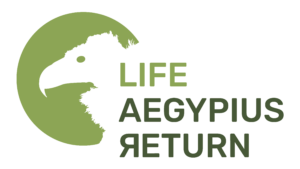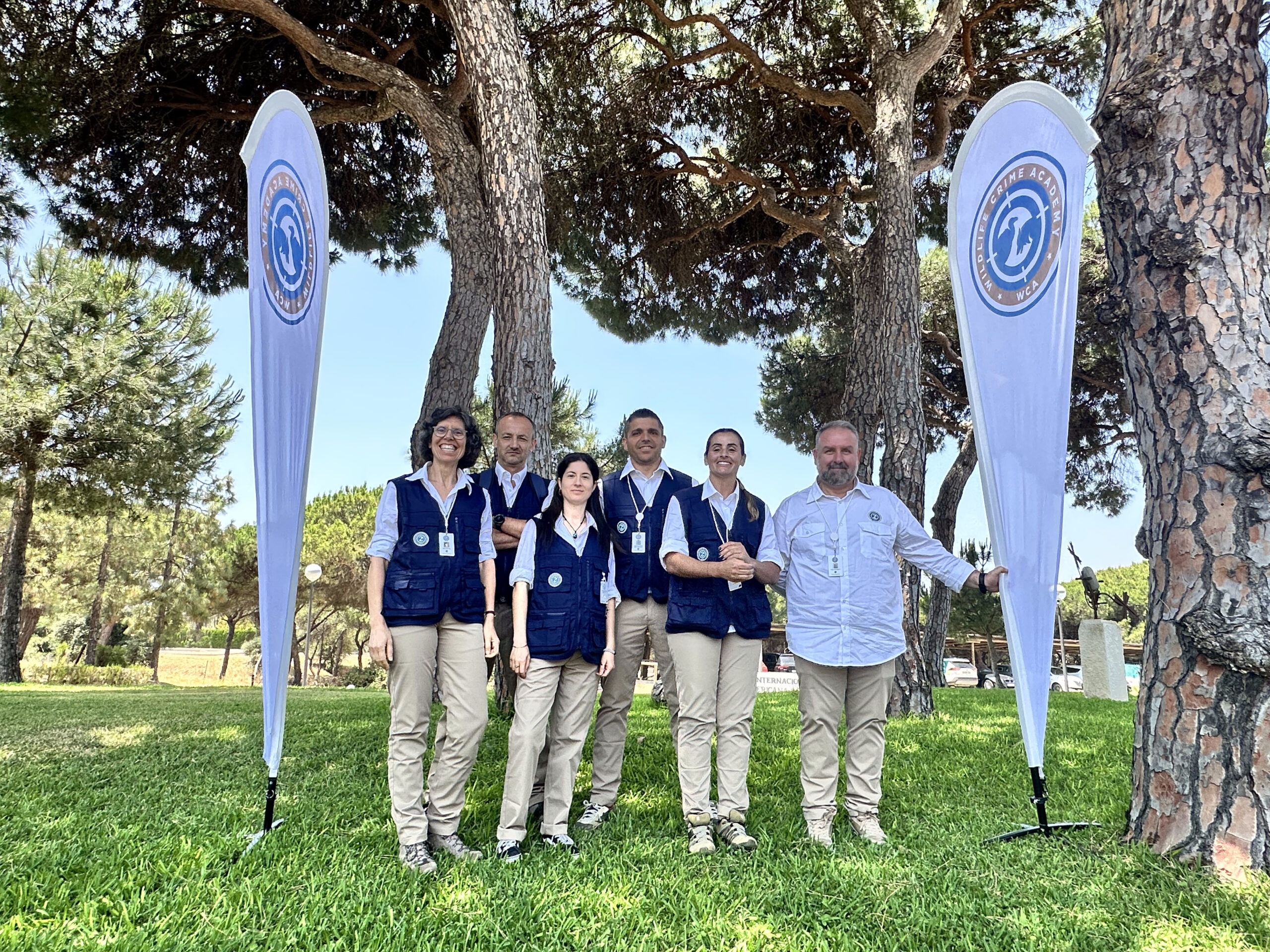During July, partners of the LIFE Aegypius Return project tagged 15 Cinereous Vulture (Aegypius monachus) chicks that hatched in the four Portuguese colonies, this breeding season. The information collected will significantly contribute to the species’ recovery in Portugal, which is expected to double by the end of 2027 and will enable to downgrade its conservation status from “Critically Endangered” to “Endangered”.


Monitoring the Cinereous Vulture breeding season in Portugal
The monitoring actions were carefully prepared at the beginning of the year, ensuring that all colonies were continuously surveyed during this breeding season. The monitoring teams have been in the field since February, checking up on every known nest, detecting new nests, and prospecting the colonies’ expansion areas and potential new settlement areas for the species.
Together with other environmental non-governmental organisations and the Institute for Nature Conservation and Forests (ICNF), project partners will be able to establish a new baseline situation for the species in Portugal, which until recently had around 40 breeding pairs. We have identified the number of breeding pairs, how many successfully laid an egg and the number of hatchlings produced this year. Soon, we will also be able to determine the reproductive success once the offspring become independent from their parents and fledge.
Promising results for the future of Cinereous Vultures in Portugal
The joint monitoring work has already delivered very promising results, which stress the importance of inter-institutional collaboration and collective efforts for the conservation of Cinereous Vultures in Portugal. There has been a considerable increase in the number of known nests used by breeding pairs, and a higher number of breeding pairs has been detected in all colonies.
The breeding season of the Cinereous Vulture is now at one of the most sensitive stages, with hatchlings growing bigger in their nests but still entirely dependent on their parents. At this stage, monitoring teams focus on ensuring offspring survival and avoiding anthropic disturbances around the nests. The results of this breeding season will be released once this sensitive phase and field work are over.
Monitoring also allows us to estimate the age of each chick, which is a crucial parameter to determine the right moment for tagging the birds. The process involves capturing the chicks while still in the nest, built on the top of trees. The chicks are brought to the ground, analysed, fitted with a GPS logger, and then returned to the nest. This methodology requires personnel duly accredited by ICNF and experienced climbers!



15 Cinereous Vulture chicks marked with GPS transmitters
The project teams have been busy tagging chicks in each colony in the last weeks. Two chicks were tagged in the Douro International Nature Park, the most fragile colony. In Serra da Malcata Nature Reserve, with the increase in breeding pairs this year, we could tag four chicks. In Tejo Internacional Nature Park, where the largest colony in the country is located and where the species started breeding again for the first time in Portugal in 2010, after becoming extinct as a breeder in the 1970s, twelve chicks were ringed and analysed, and six were fitted GPS transmitters. Finally, three additional chicks were tagged at Herdade da Contenda in Alentejo, the southernmost colony. When the 15 chicks tagged leave their nests, we will follow their movements in real-time, enabling the local teams to act swiftly in case they are at risk.





A strange lump detected
One of the Tejo Internacional Natural Park hatchlings had a lump near the eye and was sent to the Centre for the Study and Recovery of Wild Animals (CERAS) in Castelo Branco. The lump was surgically removed, and the bird will remain in the wildlife rescue centre until it fully recovers. This episode also demonstrates the importance of collaboration between various entities and interdisciplinary articulation.



Doubling the Cinereous Vulture population in Portugal: the LIFE Aegypius Return project
The LIFE Aegypius Return project aims to consolidate and accelerate the return of the Cinereous Vulture in Portugal and western Spain by improving habitat and food availability and minimising the main threats with capacity-building actions for national entities and agents. A joint effort by the project’s nine partner organisations, collaborating with several key entities to implement specific conservation actions in ten Natura 2000 areas along almost the entire border between Portugal and Spain. The project aims to double the population of Cinereous Vultures in Portugal to 80 pairs in 5 colonies and thus lower the national conservation status of the species from “Critically Endangered” to “Endangered” by 2027.
Acknowledging the collaboration of all professionals and organisations involved in tagging the chicks
The work done so far showcases that effective nature conservation thrives through collaborative efforts among institutions and various fields of knowledge. Tagging the offspring required a strong articulation between project partners, cooperating entities and authorities. It involved the work of many biologists, veterinarians and other professionals, to whom we are deeply thankful.






INTERNATIONAL DOURO : Patricia Mateo-Tomás, María Fernández García and team from the University of Oviedo; Javier de la Puente, bird conservation specialist and collaborator at Palombar; Jose Francisco Pedreño, Dirección General de Emergencias – Cuerpo de Agentes Forestales de la Comunidad de Madrid; the Division of Classified Areas and Rangers of the ICNF – Regional Directorate for Nature Conservation and Forests (DRCNF) of the North; the veterinary team of the Wild Animal Recovery Centre of the Veterinary Hospital of the University of Trás-os-Montes and Alto Douro (CRAS-HVUTAD) and the Centre for Environmental Interpretation and Animal Recovery (CIARA); and the partners Palombar, Liga para a Protecção da Natureza (LPN), Associação Transumância e Natureza (ATNatureza) and GNR/SEPNA (Territorial Command of Torre de Moncorvo); Viridia – Conservation in Action, for the financial support for action development in International Douro.
SERRA DA MALCATA : Carlos Pacheco, Filippo Guidantoni, Rangers and ICNF – DRCNF Centre; Rewilding Portugal; partners ATNatureza, LPN and GNR/SEPNA (Guarda Territorial Command).
INTERNATIONAL TEJO : Alfonso Godino, Hawk Mountain Sanctuary and Department of Toxicology – Faculty of Veterinary Medicine – University of Murcia (Spain), with support from Endesa; Quercus – National Association for Nature Conservation and team from the Castelo Branco Centre for the Study and Recovery of Wild Animals (CERAS); Rangers and ICNF – DRCNF Centre and partners from the Portuguese Society for the Study of Birds (SPEA), LPN and GNR (Núcleo de Proteção Ambiental from Idanha-a-Nova, District Command from Castelo Branco).
HERDADE DA CONTENDA : Carlos Pacheco, Rangers and ICNF – DRCNF Alentejo; partners Herdade da Contenda, LPN, Vulture Conservation Foundation (VCF), Palombar and GNR/SEPNA (Núcleo de Proteção Ambiental from Moura, District Command from Beja).
___

The LIFE Aegypius Return is a 3.7 million project, co-financed by the European Union’s LIFE Programme, whose success relies on the involvement of all relevant stakeholders and the extensive collaboration of the leading project partner, the Vulture Conservation Foundation (VCF), with all local partners: Palombar – Conservação da Natureza e do Património Rural, Herdade da Contenda, Sociedade Portuguesa para o Estudo das Aves (SPEA), Liga para a Protecção da Natureza (LPN), Associação Transumância e Natureza (ATN), Fundación Naturaleza y Hombre (FNHY), Guarda Nacional Republicana (GNR) and Associação Nacional de Proprietários Rurais Gestão Cinegética e Biodiversidade (APNC).




